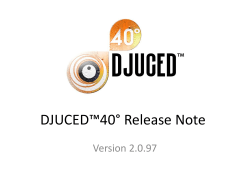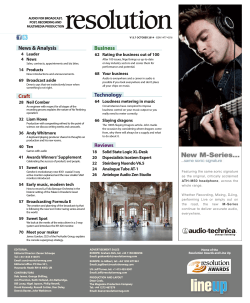
NDN-RTC
NDN-RTC Peter Gusev UCLA REMAP 9/5/2014 NDNComm 2014 Demo • • • Producer 1: Live NDNComm HD streaming (1080p 30fps, 1.5Mbps) Producer 2: REMAP office webcam producer (SD, 30fps, 500Kbps) Demo 1: – – • – Consumer for 3 streams: NDNComm, REMAP and Demo-1 Producer: webcam producer (SD, 25fps, 500Kbps) Demo-2 producer+consumer NDN-Comm producer REMAP CAIDA/UCSD Demo 2: – 1/6/2015 Consumer for 3 streams: NDNComm, REMAP and Demo-2 Producer: webcam producer (SD, 25fps, 500Kbps) Demo-1 UA (arizona) Simulated periodic link break REMAP-1 producer Demo-2 Demo-1 producer+consumer 2 NDN Real Time Conferencing Library Goals: – Real-time audio/video/text chat library which allows many-tomany conferencing over the NDN network and requires no direct communication between peers – Starting point for NDN traffic congestion control algorithm research – Test NDN-CPP library and NFD – Traffic generator for the testbed Initial gains over IP: – No load on a publisher (network does content distribution) – Intrinsic multicast (one-to-many and many-to-many scenarios) – On track for peer-to-peer with no STUN, TURN, etc. 1/6/2015 3 NDN-RTC library • C++ code • Linked against NDN-CPP and WebRTC libraries • Interfaces: – Publish media (audio/video) streams – Fetch media (audio/video) streams from multiple producers • Demo app is provided – Publishing audio/video stream – Fetching audio/video streams (multiple) 1/6/2015 4 Publisher 1/6/2015 5 Publisher. Multiple encoder threads 1/6/2015 6 Publisher. Multiple media streams Cache interests data NDN 1/6/2015 7 Segmentation • Encoded frames (1Mbps): – Key: ~30KB (20 segments) – Delta: ~1-6KB (~4 segments) • Producer stores segments in app cache – Segment size - 1000 bytes – NDN overhead - ~330-450 bytes – Complete segment less than MTU 1/6/2015 8 User namespace • Root: – User prefix (username) • streams Media streams: – Media streams (audio/video) – Streams meta info • audio0 Encoding threads: thread1 – Individual encoding parameters • video0 thread1 Frame type: Packet: – Individual media packets (audio samples, encoded video frames) • video1 thread2 stream info media streams encoding threads thread3 frames – Key and Delta frames in separate branches • root /<root>/ndnrtc/user/<producer-id>/ 0 Data type: delta key 1 ... packet_type N packet – Data and Parity segments in separate branches • data Segments: data_type parity – Actual NDN-data objects %00 1/6/2015 %01 ... %MM %00 %01 segment 9 Consuming Interest pipeliner Interests NDN Segments %00%N1 %00%N2 ... %00%NN playhead Buffer Renderer 1/6/2015 Raw frame Decoder Playout Encoded frame 10 Frame fetching • Generation delay dngen – time interval between receiving an interest and satisfying it with data (producer-side) • Assembling time dnasm – time needed to fetch all frame segments (consumer side) • RTTn – consumer-measured round trip time for the interest (consumer side) 1/6/2015 11 Interest pipeline and retransmission B1 >= RTT, B2 >= RTT Minimal buffer size >= 2*RTT milliseconds 1/6/2015 12 Chase mode • There is no direct coordination b/w consumers and producers • Producer generates data at high rate (~20-30FPS) and this data becomes outdated fast • Start-up time: consumer is aware that stale data is present in the network and tries to avoid playing it back • Chasing mechanism: – Cache exhaustion: • Latest data can not arrive faster than it’s being produced – it arrives at producer’s rate • Cached data arrives with the same frequency it was requested – Chase mode: • issue interest for the RIGHTMOST segment • upon receiving first segment – start issuing interests for the next frames with interval dint < Producer rate • Monitor darr – frame inter-arrival interval: – If darr is increasing – continue fetching – If darr is stable – switch to “Fetch“ mode 1/6/2015 13 Chase mode (cont.) d arr 70 Chase mode Fetch mode 60 Milliseconds 50 40 30 20 10 0 200 400 600 800 1000 1200 1400 1600 1800 2000 Milliseconds Future improvement (suggested by Dave Oran): 1. piggyback video sync data on audio stream 2. use audio stream for chasing instead of video 1/6/2015 14 Forward Error Correction • OpenFEC library • Producer publishes parity data under separate namespace: – <frame prefix>/<frame#>/parity/<segments> • Consumer may additionally fetch parity data for enabling FEC • If by the playback time frame is missing any segments – FEC is applied as the “last resort” • Amount of parity data is configurable (currently 20%) • Collaborated with Daisuke Ando (Exchange student from Japan) • Future improvement (suggested by Dave Oran): use framelevel parity data rather than segment-level 1/6/2015 15 Demo app • Console app – MacOS X 10.9 and up – Buildable from sources github.com/remap/ndnrtc – Redmine redmine.nameddata.net/projects/ndnrtc • Functionality: – Publish audio/video stream – Fetch multiple audio/video streams 1/6/2015 16 Future steps • Real-time Adaptive Rate Control: – – – – – – • • • • • In collaboration with Panasonic R&D department (Muramoto-san, Yoneda-san) Keep low-latency transmission & best throughput Maintain RTT fairness (self-fairness) Consumer-driven NW bandwidth estimation based on RTT and timeouts Control interest rate according to bandwidth estimation Conference discovery (Zhehao Wang) Text chat (Zhehao Wang) Browser integration (Zhehao Wang) Security Desktop conference tool – Adding modularity to the existing code • Compare to existing solutions – Can be RTC over NDN better than IP? • Scalability tests 1/6/2015 17 Areas for future research • Interests pipelining – Express just enough interests to fetch needed frames and meet the deadline, but keep low latency • Alternatives to cache exhaustion – How consumer can be sure that it’s getting the latest data from the network without explicit producer-consumer signaling? • Security – Trust model; signing and verification; encryption approach? • Scalability – How many conference peers can there be? – What are the requirements for the forwarder? – What are the requirements for the peers? • Relationship between forwarder strategy and application – Best route strategy 2 1/6/2015 18 Links • Source code – https://github.com/remap/ndnrtc – branches: • master – current released version (v0.9.alpha4) • dev – current development branch (v0.9.alpha5) • MacOS binaries (library, demo, supporting files) – https://github.com/peetonn/ndnrtc-archive – Special branch for demo events: • demo/ndncomm2014 • Redmine – http://redmine.named-data.net/projects/ndnrtc/issues 1/6/2015 19 Thanks Q&A Peter Gusev peter@remap.ucla.edu 1/6/2015 20
© Copyright 2025


















